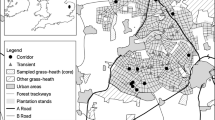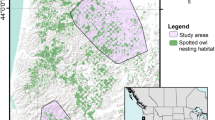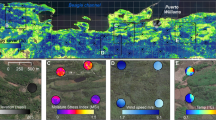Abstract
The specific dispersal/colonization strategies used by species to locate and colonize habitat patches can strongly influence both community and metacommunity structure. Habitat selection theory predicts nonrandom dispersal to and colonization of habitat patches based on their quality. We tested whether habitat selection was capable of generating patterns of diversity and abundance across a transition of canopy coverage (open and closed canopy) and nutrient addition by investigating oviposition site choice in two treefrog species (Hyla) and an aquatic beetle (Tropisternus lateralis), and the colonization dynamics of a diverse assemblage of aquatic insects (primarily beetles). Canopy cover produced dramatic patterns of presence/absence, abundance, and species richness, as open canopy ponds received 99.5% of propagules and 94.6% of adult insect colonists. Nutrient addition affected only Tropisternus oviposition, as females oviposited more egg cases at higher nutrient levels, but only in open canopy ponds. The behavioral partitioning of aquatic landscapes into suitable and unsuitable habitats via habitat selection behavior fundamentally alters how communities within larger ecological landscapes (metacommunities) are linked by dispersal and colonization.



Similar content being viewed by others
References
Bernath B, Szedenics G, Wildermuth H, Horvath G (2002) How can dragonflies discern bright and dark waters from a distance? The degree of polarization of reflected light as a possible cue for dragonfly habitat selection. Freshw Biol 47:1707–1719
Binckley CA, Resetarits WJ Jr (2003) Functional equivalence of non-lethal effects: generalized fish avoidance determines distribution of gray treefrog, Hyla chrysoscelis, larvae. Oikos 102:623–629
Binckley CA, Resetarits WJ Jr (2005) Habitat selection determines abundance, richness and species composition of beetles in aquatic communities. Biol Lett 1:370–374
Blaustein L (1999) Oviposition site selection in response to risk of predation: evidence from aquatic habitats and consequences for population dynamics and community structure. In: Wasser SP (ed) Evolutionary theory and processes: modern perspectives. Kluwer, Netherlands, pp 441–456
Blaustein L, Kotler BP (1993) Oviposition habitat selection by the mosquito, Culiseta longiareolata: effects of conspecifics, food and green toad tadpoles. Ecol Entomol 18:104–108
Brodin T, Johansson F, Bergsten J (2006) Predator related oviposition site selection of aquatic beetles (Hydroporus spp.) and effects on offspring life-history. Freshw Biol 51:1277–1285
Caspersen JP, Pacala SW, Jenkins JC, Hurtt GC, Moorcroft PR, Birdsey (2000) Contributions of land-use history to carbon accumulation in US forests. Science 290:1148–1151
Chen H, Tian H, Liu M, Melillo J, Pan S, Zhang C (2006) Effect of land-cover change on terrestrial carbon dynamics in the southern United States. J Environ Qual 35:1533–1547
Fretwell SD, Lucas HL Jr (1970) On territorial behavior and other factors influencing habitat distribution in birds. I. Theoretical development. Acta Biotheor 19:16–36
Fairchild GW, Cruz J, Faulds AM, Short AEZ, Matta JF (2003) Microhabitat and landscape influences on aquatic beetle assemblages in a cluster of temporary and permanent ponds. J North Am Benthol Soc 22:224–240
Frost CC (1995) Presettlement fire regimes in southeastern marshes, peatlands, and swamps. In: Cerlean SI, Engstrom RT (eds) Fire in wetlands: a management perspective (Proc Tall Timbers Fire Ecology Conf, No. 19). Tall Timbers Research Station, Tallahassee, FL, pp 39–60
Grether GF, Millie DF, Bryant MJ, Reznick DM, Mayea W (2001) Rainforest canopy cover, resource availability, and life history evolution in guppies. Ecology 82:1546–1559
Groom MJ, Schumaker N (1993) Evaluating landscape change: Patterns of worldwide deforestation and local fragmentation. In: Kareiva PM, Kingsolver JG, Huey RB (eds) Biotic interactions and global change. Sinauer Associates, Sunderland, MA, pp 24–44
Halverson MA, Skelly DK, Kiesecker JM, Freidenburg LK (2003) Forest mediated light regime linked to amphibian distribution and performance. Oecologia 134:360–364
Hanski I, Singer MC (2001) Extinction–colonization dynamics and host-plant choice in butterfly metapopulations. Am Nat 158:341–353
Hill WR, Mulholland PJ, Marzolf ER (2001) Stream ecosystem responses to forest leaf emergence in spring. Ecology 82:2306–2319
Holt RD (1993) Ecology at the mesoscale: the influence of regional processes on local communities. In: Ricklefs RE, Schluter D (eds) Species diversity in ecological communities. University of Chicago Press, Chicago, IL, pp 77–88
Holt RD, Barfield M (2001) On the relationship between the ideal-free distribution and the evolution of dispersal. In: Clobert J, Danchin D, Dhondt A, Nichols J (eds) Dispersal. Oxford University Press, New York, pp 83–95
Holyoak M, Leibold MA, Holt RD (2005) Metacommunities: spatial dynamics and ecological communities. University of Chicago Press, Chicago, IL
Kneitel JM, Miller TM (2003) Dispersal rates affect species composition in metacommunities of Sarracenia purpurea inquilines. Am Nat 162:165–171
Leibold MA, Wilbur HM (1992) Interactions between food-web structure and nutrients on pond organisms. Nature 360:341–343
Leibold MA, Holyoak M, Mouquet N, Amarasekare P, Chase JM, Hoopes MF, et al. (2004) The metacommunity concept: a framework for multi-scale community ecology. Ecol Lett 7:601–613
Matta JF (1979) Aquatic insects of the Dismal Swamp. In: Kirk PW (ed) The Great Dismal Swamp. University of Virginia Press, Charlottesville, VA, pp 200–221
Maynard Smith J (1982) Evolution and the theory of games. Cambridge University Press, Cambridge
Mayhew PJ (1998) Testing the preference performance hypothesis in phytophagous insects: lessons from chrysanthemum leafminer (Diptera: Agromyzidae). Environ Entomol 27:45–52
Morris DW (2003) Toward an ecological synthesis: a case for habitat selection. Oecologia 136:1–13
Nilsson AN, Svensson BW (1995) Assemblages of dytiscid predators and culicid prey in relation to environmental factors in natural and clear-cut boreal swamp forest pools. Hydrobiologia 308:183–196
Odum WE, Odum EP, Odum HT (1995) Nature’s pulsing paradigm. Estuaries 18:547–555
Palik B, Batzer DP, Buech R, Nichols D, Cease K, Egeland L, Streblow DE (2001) Seasonal pond characteristics across a chronosequence of adjacent forest ages in northern Minnesota, USA. Wetlands 21:532–542
Resetarits WJ Jr (2001) Experimental evidence that past predation affects community assembly: fish avoidance in a colonizing/ovipositing aquatic beetle. Oecologia 129:155–160
Resetarits WJ Jr (2005) Habitat selection behaviour links local and regional scales in aquatic systems. Ecol Lett 8:480–486
Resetarits WJ Jr, Wilbur HM (1989) Choice of oviposition site by Hyla chrysoscelis: role of predators and competitors. Ecology 70:220–228
Resetarits WJ Jr, Binckley CA, Chalcraft DR (2005) Habitat selection, species interactions, and processes of community assembly in complex landscapes: a metacommunity perspective. In: Holyoak M, Leibold MA, Holt RD (eds) Metacommunities: spatial dynamics and ecological communities. University of Chicago Press, Chicago, IL, pp 374–398
Ricklefs RE (1987) Community diversity: relative roles of local and regional processes. Science 235:167–171
Rieger JF, Binckley CA, Resetarits WJ Jr (2004) Larval performance and oviposition site preference along a predation gradient. Ecology 85:2094–2099
Rosenzweig ML (1991) Habitat selection and population interactions: the search for mechanism. Am Nat 17:s5–s28
Rubbo MJ, Kiesecker JM (2004) Leaf litter composition and community structure translating: regional species changes into local dynamics. Ecology 84:2519–2525
Shurin JB (2001) Interactive effects of predation and dispersal on zooplankton communities. Ecology 82:3404–3416
Skelly DK, Werner EE, Cortwright SA (1999) Long-term distribution dynamics of a Michigan amphibian assemblage. Ecology 80:2326–2337
Skelly DK, Freidenburg LK, Kiesecker JM (2002) Forest canopy and the performance of larval amphibians. Ecology 83:983–992
Sutherland WJ (1996) From individual behaviour to population ecology. Oxford University Press, Oxford
Tilman D, Reich P, Phillips H, Menton M, Patel A, Vos E, Peterson D, Knops J (2000) Fire suppression and ecosystem carbon storage. Ecology 81:2680–2685
Tuno N, Okeka W, Minakawa N, Takagi M, Yan G (2005) Survivorship of Anopheles gambiae sensu stricto (Diptera: Culicidae) larvae in Western Kenya highland forest. J Med Entomol 42:270–277
Van Baalen M, Hochberg ME (2001) Dispersal in antagonistic interactions. In: Clobert J, Danchin D, Dhondt A, Nichols J (eds) Dispersal. Oxford University Press, New York, pp 299–310
Wellborn GA, Werner EE, Skelly DK (1996) Mechanisms creating community structure across a freshwater habitat gradient. Ann Rev Ecol Syst 27:337–363
Werner EE, Glennemeier KS (1999) Influence of forest canopy cover on breeding pond distributions of several amphibian species. Copeia 1999:1–12
Wilbur HM (1997) Experimental ecology of food webs: complex systems in temporary ponds. Ecology 78:2279–2302
Williams DD (2006) The biology of running waters. Oxford University Press, Oxford
Zalom FG, Grigarick AA (1980) Predation by Hydrophilus triangularis and Tropisternus lateralis in California rice fields. Ann Entomol Soc Am 73:167–171
Zalom FG, Grigarick AA, Way MO (1979) Habits and relative population densities of some Hydrophilids in California rice fields. Hydrobiologia 75:195–200
Acknowledgments
We thank J. Bolin and J. Rieger for assistance in the field. D. Chalcraft, J. Davenport, C.P. Doncaster, A. Gonzalez, L. Horth, J. Lear, J. Ray, T. Rogers, and two anonymous reviewers greatly improved the manuscript. Funded by NSF (DEB-0096051, DEB-0516298) and EPA-STAR (R825795–01-0) grants to WJR. Experiments comply with current United States’ law.
Author information
Authors and Affiliations
Corresponding author
Additional information
Communicated by Andrew Gonzales.
Rights and permissions
About this article
Cite this article
Binckley, C.A., Resetarits, W.J. Effects of forest canopy on habitat selection in treefrogs and aquatic insects: implications for communities and metacommunities. Oecologia 153, 951–958 (2007). https://doi.org/10.1007/s00442-007-0780-5
Received:
Accepted:
Published:
Issue Date:
DOI: https://doi.org/10.1007/s00442-007-0780-5




